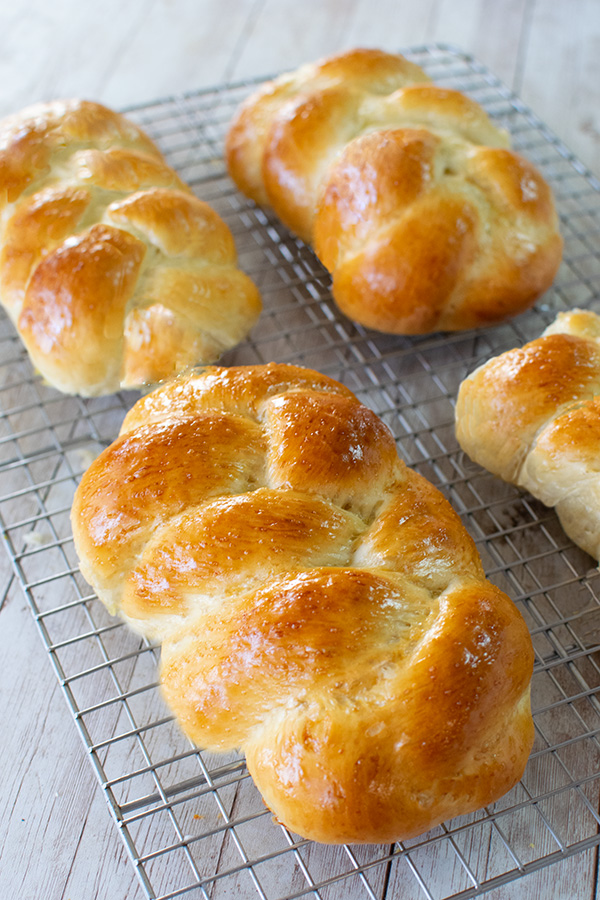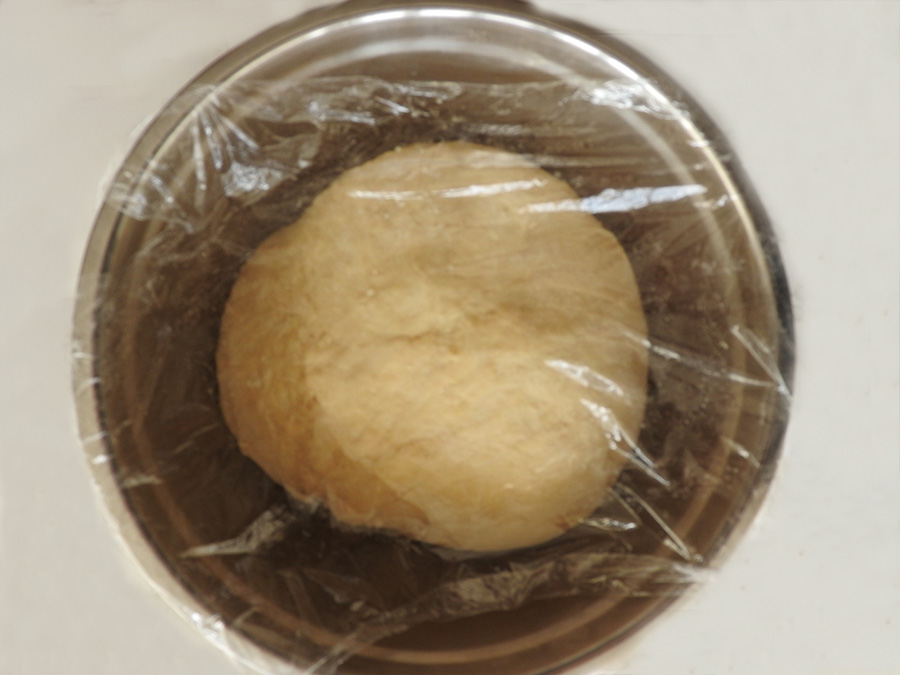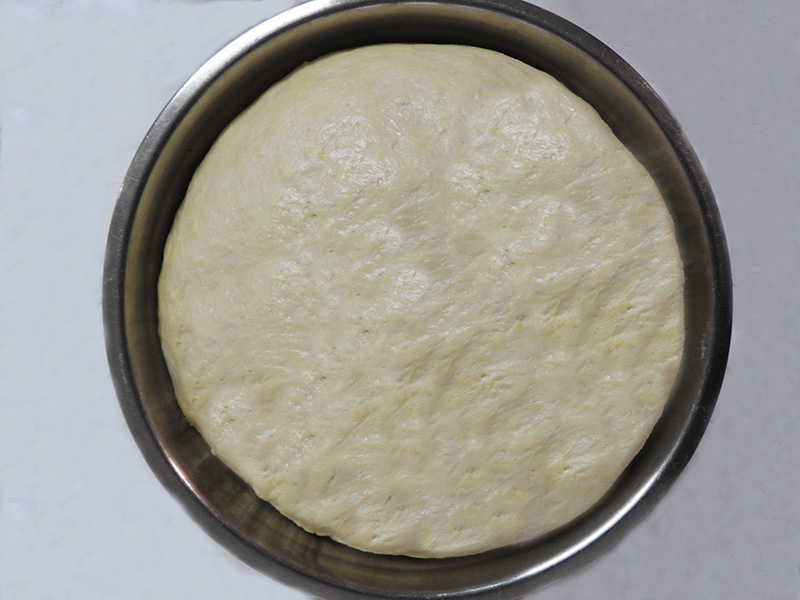This Water Challah Rolls recipe is an easy 5-ingredient recipe for delicious and fluffy Jewish challah bread rolls made without any eggs.

Challah, a braided bread, is eaten primarily on Shabbat and on Jewish holidays. Two challahs should be present at each traditional meal during these days. https://aish.com/six-facts-about-challah/
I tried many challah recipes. Some came out good, some not. Every week, my family had no idea what to expect. It wasn’t the recipe, it was me. I just couldn’t get the hang of making great challahs week after week.
With this Water Challah Rolls recipe, I have yet to mess them up even once after all these years.
It may look like a complicated recipe, because of the steps, but it is actually very simple to make. The longest step of the whole process is waiting for the dough to rise!
…. and the outcome is SO fluffy and SO good that you may never want to bother to buy rolls from the store again!!
Prefer challah rolls with egg? Challah Rolls Recipe
A little background
Every once in a while, I will come across something that looks easy enough for me to say, “I can do that,” and I will try.
This is true for crafts, sewing, cooking, and baking, and I will often try…and I will keep trying until I am satisfied that I’ve mastered whatever-it-is or accept that I just am not going to.
Well, one of those things, years ago, was challah.
I got a recipe from a friend and decided to try.
Now, I am one of those people who will often look at instructions if I need to, and sometimes, I follow them “kind of.”
My kids have shown me buttons and options on appliances and electronics that I have been using for years and never even noticed.
More often than not, I cook by “how it looks” and have been caught measuring salt and spices with the palm of my hand.
I am embarrassed to say, that once my daughter caught me even about to measure oil this way.
“You are NOT going to measure oil in your hand. Are you??”
Well, let me tell you right now, I never did THAT again.
One may be able to get away with this behavior with cooking – you know, adapt the ingredients to taste or throw in what looks good – but not so much with baking.
Yeah, I found that out the hard way with the challahs.
Week after week I tried, but instead of coming out fluffy, they came out flat. I mean, they were closer to being flat pita than they were fluffy challahs.
Finally, I would give up, and I think that everyone was grateful to have the store bought once again.
However, every once in a while, I would try again. It would be hit or miss as to how good they came out.
Then, one day, it hit me. The instructions often will tell you how long to let the dough rise, or they will say to let it “double in size” both before and after forming the challah.
However, me being the logical person I am, I thought, If the formed, but raw, challahs are fluffy at double the size, wouldn’t they be fluffiER if I let them rise more?
The short answer to that is…NO! While the raw challahs look nice and large, when they are in the oven, they will FALL.
Now, my challahs never fail. I make them now pretty much every week and even bake them for my parents. They always come out good, and my family loves them (once I used store-bought because I didn’t have time, and everyone was disappointed).
THAT is how you know you are doing a good job!
Another point: instructions will also often say how long to knead the dough. I have NEVER followed these. I use a stand mixer (easier and more efficient than kneading by hand) and just knead for a few minutes past the point when the dough is smooth and like a slightly sticky Play-Doh).
Making good challahs doesn’t take a baker. All one needs is a good recipe and to pay attention.
After all of my kitchen blunders over the years and being convinced that I would never get it right no matter how much I tried, my motto is, If I can do it, anyone can.
And with this recipe…anyone can!
Are challahs traditionally dairy or non-dairy?
Challahs are traditionally non-dairy. This is because they are for Jewish occasions, which mostly include meat meals, and Torah-observant Jews do not eat meals that combine meat with milk.
Braided challahs are mostly used on Shabbat or at an event like a wedding, bris, or bar mitzvah. However, round challahs are traditionally used for holidays. (There is no absolute rule to this.).
Even challah made with eggs is not dairy. Contrary to what some people believe, eggs are NOT dairy (you cannot milk a chicken).


For fluffier challah, should I let the braided dough rise more than double?
This is an absolute, hard NO. It’s not so important for your dough to have risen exactly double – it’s just an approximation. However, as I mentioned in the background section above, if it rises too much, it can fall when baking. Over-rising can also cause the dough to be bitter and taste like beer from the over-fermenting of the yeast.
Can I freeze?
Absolutely YES. Just make sure to wrap or bag well, because otherwise it can become freezer-burnt.
Easy Fluffy Water Challah Rolls does not call to proof the yeast. Why not?
Proofing (or blooming) the yeast is only to be certain that the yeast is still active and your challah will rise. Proofing is when you take your yeast, a little warm water, and a little sugar and mix them together.
If you are concerned that your yeast may no longer be active, then certainly proof it before using.
If your yeast is active, it will normally bubble within 5 – 10 minutes. If you don’t see it in that amount of time, I would wait longer just in case before you throw it out (especially if you buy large bags like I do).
If you proof your yeast for this recipe, you should use water and sugar from the quantities that the recipe already calls for.
How simple is it to make Easy Fluffy Water Challah Rolls?
While the list of instructions is long and the start-to-finish time is long, the bottom line is that Easy Fluffy Water Challah Rolls takes minimal effort. All you do is mix the ingredients, let sit to rise, form the challahs, let rise again, and bake. That’s it! (If egg is not a problem, you can coat with egg for color and shine.).
Everyday pantry essentials (suggested)
As I learned to prepare more and more recipes, I also learned which basics and seasonings are good to have on hand to have the ability to make a dish on short notice and not have to run out to the store or borrow from a neighbor.
While I will admit that I am not always prepared when one of my kids asks for eggplant parmesan or lasagna at the drop of a hat (which they have done), I dislike having to postpone making something just because the ingredients needed to make a reasonable meal were not readily available.
So, I maintain a selection of what I consider “pantry essentials” in my refrigerator and on my shelves at all times.
Initially, many of the herbs and spices were useful to me only on occasion (having been purchased for a particular recipe), and I usually just had them around as leftovers. However, as I began to cook more of a variety, I was really glad to have them (hey, look, I already have that!). And that is how my list began.
While, of course, most of the essentials will not be needed just for any one recipe, at least some of them are needed for most recipes, and you would be surprised how many recipes can be made just with this list. So, if you keep whatever you use regularly on hand, it can really save you time and effort.
Everyone has their favorite recipes, preferred seasonings, and just whatever they like to use to cook. Your own list should certainly reflect your own cooking tastes and style.
Just to give you an idea, the list below is a comprehensive list of what I normally keep on hand (this does not necessarily include what I keep for baking, and there may be some overlap between the two lists as some items are used for both, such as brown sugar), and, of course, it reflects the meals and desserts that I like to make for my own family and guests.
Utensils:
- Measuring cups for liquid
- Measuring cups for solids (flour, sugar, etc.)
- Measuring spoons
- Mixing bowls
- Kitchen scale
NOTE: When using measuring cups and spoons, make sure that the measurements are comparable to one another (example: that 4 tablespoons equals 1/4 of your measuring cup). You’d be surprised to know that not all measuring cups are the same, and this can throw your measurements off.
Seasoning and flavoring:
- salt (my recipes use regular table salt)
- ground black or white pepper
- granulated garlic or garlic powder (I prefer granulated)
- onion powder
- sweet paprika and/or sweet pepper flakes (paprika is ground dried red pepper, pepper flakes are crushed dried red pepper)
- hot paprika, hot pepper flakes, or cayenne pepper (moderately spicy dried ground chili pepper) for those occasional spicy dishes
- ground turmeric
- ground cumin
- ground cinnamon
- ground ginger
- ground nutmeg
- ground cloves (for pumpkin flavors)
- sugar (granulated)
- brown sugar
- chicken consommé powder / beef bouillon powder (regular or vegetarian)
- onion soup mix
- onion flakes (substitute for fresh onion—3 tablespoons for 1 medium onion).
- various herbs
- additional spices to adapt taste to preference
Misc:
- oil / margarine / butter / cooking spray
- coconut cream as a dairy-free cream substitute
- flavorless milk substitute as a dairy-free milk alternative
- cornstarch as a thickening agent
- flour
- baking powder
- baking soda
- bread crumbs or cornflake crumbs (you can make these with your blender or food processor) for coating
- condiments, such as ketchup, mustard, barbecue sauce
- tomato sauce/tomato paste/canned tomatoes—diced or crushed/pasta sauce
- soy sauce
- ready-made pie crusts and dough (to just add filling)
We always have eggs in the fridge and onions, rice, and potatoes on our shelves, as well as pasta.
In addition, having some fresh vegetables in the fridge, such as carrots, celery, tomatoes, bell peppers (various colors), etc., can be very useful when putting together a quick but delicious meal.
It is also a good idea to have some ground meat or chicken (breast, ground, or in parts) in the freezer for anyone who likes meat dishes in a snap.
Weather can have an effect on some of the spices and on the chicken consommé powder, so I keep as many of the seasonings in the refrigerator or freezer as I can, and I keep everything tightly closed in containers (you will be surprised to know just how determined moths are at getting into sealed bags and how hot red pepper powder can attract little black bugs—YUCK!).
Therefore, store your items well.
Why are these pantry essentials beneficial to have on hand?
Personally, having the above ingredients in my kitchen is very advantageous, as I make a variety of dishes and use most of the items on the list regularly enough to warrant storing them. However, I do not store items for dishes that I make seasonally or only on rare occasions or those that spoil easily.
Whether or not it is workable for you depends on your cooking style, the space you have to store, and whether or not you mind running out to the store as needed. Of course, the more you cook and the more varied your recipes, the more you will use and the more you will need.
Water Challah Rolls

Easy Challah roll recipe for delicious fluffy challah rolls made without egg.
Ingredients
- 8 cups (1 kg or 2.2 pounds) flour
- 1/2 cup oil
- 1/2 cup sugar
- 3 tablespoons instant dry yeast
- 1 tablespoon salt
- 1 1/2 - 2 cups warm water
- 1 egg for coating (if desired - do not coat if you want vegan or egg free)
- sesame seeds, poppy seeds, etc for topping, if desired (they may not stick well without the egg coating)
Instructions
- Pour flour into large bowl (I sift first).
- Add oil, sugar, salt, and yeast.
- Mix with mixer on low or knead by hand, adding water a little at a time until the dough has become like a slightly sticky Play-doh and then mix for a few more minutes.
- Cover bowl with plastic wrap (you can use a damp cloth towel, however if the dough rises to that point, it will stick to the towel).
- Let rise until the dough approximately doubles in size (it doesn't have to be exact).
- Remove dough from bowl and place on a lightly floured surface (the stickier your dough, the more flour you will need, because you want to be able to work with it without it sticking to your work surface).
- Roll into ropes of around 1" in diameter.
- Braid to the size you desire. *
- Tuck ends underneath to finish.
- Place the rolls on a cookie sheet that has been lightly coated with oil or spray (I use baking sheets) as you make them.
- Beat egg and brush over rolls, if desired (If you don't want to coat with egg, skip this process).
- Let the rolls sit to rise until they have approximately doubled in size (it doesn't have to be exact, but do not let them rise too much as they may fall when baking).
- Place in oven on a middle shelf that has been pre-heated to 350°F.
- Bake for approximately 20 minutes or until they browned somewhat (at least a light golden brown). If you need to, swivel the cookie sheet around after approximately 10 minutes for more even baking.
- Remove from oven and let cool.
- If you choose not to coat with egg, but still want some shine, coat very lightly with a little oil or cooking spray after they cool.
Notes
1) If you want a more yellow color to the rolls like you find in he bakeries, add a little turmeric (too much and it may taste like soap) or a little yellow food coloring. 2) If you are not certain your yeast is active, proof first by mixing a little warm water with a couple of tablespoons of the sugar and the yeast. Let it sit for around 10 minutes for it to bubble. Then, pour it in to the mixing bowl and mix with the rest of the ingredents before you add the remainder of the water.
* Or tie in knots. The amount of rolls will be determined by how large or small you make them.
Nutrition Information:
Yield:
12Serving Size:
1Amount Per Serving: Calories: 139Total Fat: 11gSaturated Fat: 1gTrans Fat: 0gUnsaturated Fat: 9gCholesterol: 0mgSodium: 533mgCarbohydrates: 10gFiber: 1gSugar: 8gProtein: 2g